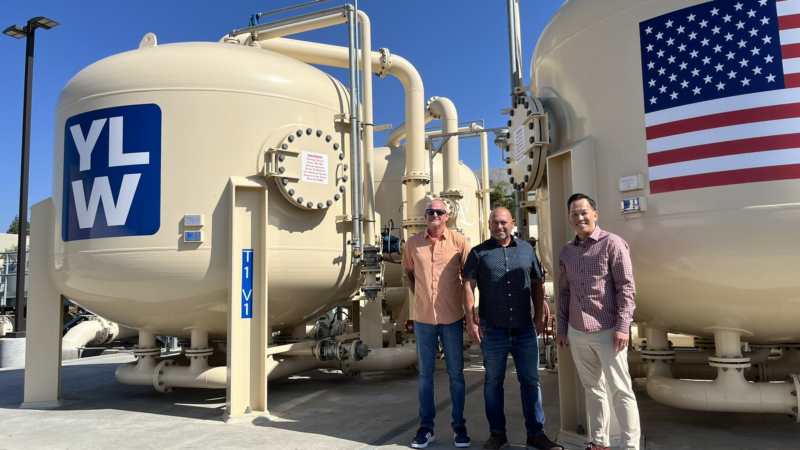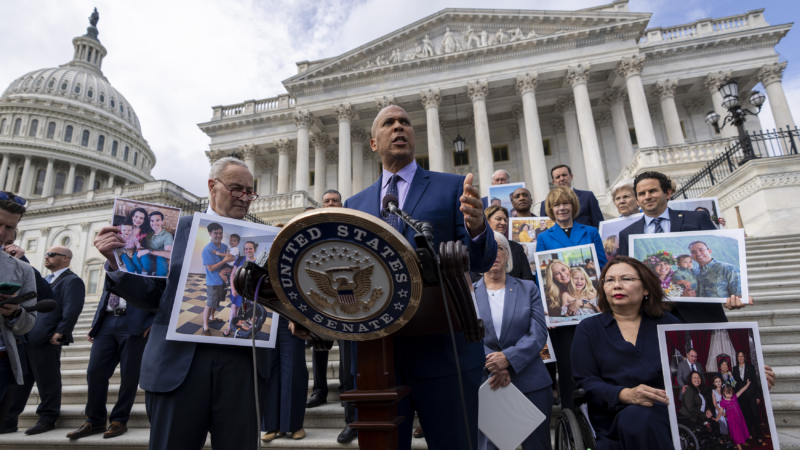How a California county got PFAS out of its drinking water
Yorba Linda is a small, sunny city southeast of Los Angeles. It’s perhaps best known for being the birthplace of President Richard Nixon.
But in the past few years, Yorba Linda has picked up another distinction: It’s home to the nation’s largest per- and polyfluoroalkyl (PFAS) water treatment plant of its kind, according to the city.
“This December will be [three] years we’ve been running, and we’re the largest PFAS treatment plant using resin,” says J. Wayne Miller, former board president at the Yorba Linda Water District, for whom the plant is named.
Across the country the Environmental Protection Agency estimates there are thousands of water systems, serving around 100 million people, that have harmful levels of PFAS in their drinking water. Under an EPA rule finalized in April, affected water districts will have to take action to clean their water supplies. In Orange County, Calif., the Yorba Linda treatment plant and others around it provide examples of how it can be done.
The Yorba Linda PFAS treatment plant took over a long, narrow strip of the water district’s parking lot, not quite the length of a football field. A series of giant tanks sit atop a concrete platform. “Honestly, they look like large propane cylinders,” says Todd Colvin, chief water system operator for the district.

Each tank looms about 10 feet tall and can hold around 4,500 gallons. There are 22 of them, arranged in a double row, painted pristine ivory white. The tanks are packed half-full with a kind of resin – special polymer beads – that pull PFAS out of the water. Every gallon of water pumped from the district’s wells now passes through a few of these tanks for treatment, before going to the homes and businesses of 80,000 people.
The Yorba Linda Water District built the largest PFAS water treatment plant of its kind because it had a big PFAS problem. In February 2020, the water district had to take all of its wells offline because they were drawing groundwater contaminated with PFAS.
PFAS refers to a large class of man-made chemicals used to waterproof and stainproof manufactured products. Some PFAS chemicals have been linked with various health problems, such as weakened immune systems, high cholesterol and certain cancers.
In Yorba Linda, all 10 of the district’s groundwater wells exceeded California’s recommended PFAS levels, which took effect in 2020 – 40 parts per trillion for PFOS and 10 parts per trillion for PFOA, two common PFAS chemicals. Water providers in the state that exceeded those limits had to stop using contaminated water or notify the public.
Those state limits, established four years before the EPA set national limits, put California’s cities ahead of the curve. “I thank my lucky stars we were on the front end of that,” says Mark Toy, general manager of the Yorba Linda Water District.
Filtration plants are expensive but cost less than imported water
The next city over is Anaheim, home to Disneyland. A few miles from Space Mountain, a paved industrial lot houses the second-largest PFAS water treatment plant of its kind. “This would be a little bit larger than a basketball court,” says Mike Lyster, spokesman for the city, estimating the footprint of the 20 filtration tanks at this site.
Lyster says there was a brief time when Anaheim had the largest PFAS treatment plant. “Kudos to Yorba Linda,” he says, “We’re glad to see somebody else beat it because that means somebody else is addressing the issue.”
Anaheim is a larger city, and the public water utility there can provide water for upwards of 500,000 people a day. Back in 2020, when California’s PFAS rules came into effect, Anaheim took 14 of its 19 wells offline for excess PFAS.
If high levels of PFAS are found in drinking water, a water provider can switch to a source without the chemicals in it or filter them out.
At first, both Anaheim and Yorba Linda swapped mostly to water imported from northern California and the Colorado River that met the state standards. But water from those sources can cost twice as much as local groundwater. Lyster says Anaheim’s water expenses went up by about $2 million a month.
So Anaheim and Yorba Linda fast-tracked construction of those big filtration tanks, to get their wells back in action.
The new EPA PFAS standards are even stricter than California’s: no more than 4 parts per trillion each for PFOA and PFOS, and additional limits for several other PFAS chemicals.
By the EPA’s standards, Anaheim’s remaining wells are now considered contaminated. Lyster says the city will expand its PFAS treatment capacity to comply with the federal rule by 2029. All told, building PFAS filtration for all 19 of Anaheim’s wells is projected to cost $200 million.
Anaheim and Yorba Linda are part of the Orange County Water District — a public agency that manages the region’s groundwater and which helped to design, fund and build the PFAS filtration plants. Across Orange County, more than 100 wells have exceeded the EPA’s new standards. Fixing the problem in the county is expected to cost $1.8 billion dollars over 30 years, according to OCWD.
Pollution from the past is still present
But where is all this PFAS coming from? In Orange County, one of the primary culprits appears to be the Santa Ana River.
Almost a hundred miles long, the Santa Ana River flows through mountains and canyons, the cities and suburbs of San Bernardino and Riverside. Along the way, it picks up PFAS. “We find it in some of just the natural runoff that goes into the river during the winter, during storms,” says Jason Dadakis, executive director of water quality and technical resources at the Orange County Water District. ”We also detect some PFAS coming out of the sewage treatment plants upstream.” There’s also the legacy of factories and military bases in the area.

In Orange County – the Santa Ana River’s last stop before the Pacific Ocean – some of the river water gets diverted to ponds where it can seep into the ground and refill the groundwater, which may have contributed to the contamination, says Dadakis.
And while the PFAS problem in Orange County is currently confined to the northern and central parts of the groundwater basin, Dadakis says wells that aren’t contaminated today could be in the future, based on how water moves underground. “We know that we may have to be prepared to install additional treatment on those wells as they become impacted,” he says.
At least Orange County has a head start on solutions. But with the size of the PFAS problem across the country, its claims on having the largest PFAS treatment plants of their kind in the nation could soon be eclipsed.
When will we know who won Georgia? Raffensperger says it depends on ‘how close it is’
NPR's Mary Louise Kelly sits down with Georgia Secretary of State Brad Raffensperger ahead of the 2024 presidential election.
Former officer testifies he beat a ‘helpless’ Tyre Nichols then lied about it
Emmitt Martin III testified that he punched the 29-year-old Black man at least five times while two Memphis police colleagues held his arms and said “hit him."
Exploding Pagers in Lebanon, Raising Tensions between Hezbollah and Israel
Authorities in Lebanon are blaming Israel for an apparent attack in which pagers, used by Hezbollah in Lebanon, exploded simultaneously. At least nine people were killed, more than 2,700 were injured. Tensions between Israel and Hezbollah, the Lebanese paramilitary group backed by Iran, had already been high and there were fears their frequent attacks on each other could escalate into all-out war. We hear about what this all could mean from our correspondent in the region.
A NASA probe is about to launch to an icy moon that could have life
A NASA mission launching in October will send cameras and other scientific equipment to see, among other things, whether Jupiter's moon Europa could sustain life.
Senate Republicans block IVF bill, as Democrats elevate issue ahead of November election
Senate Republicans blocked a bill to ensure federal protections for access to in vitro fertilization treatments, calling it a "show" vote by Democrats. Republican leaders and Former President Trump, the GOP nominee for president, say they back IVF but not the legislation proposed by Democrats.
Dual missions strain Secret Service when the job is harder than ever
NPR's Ari Shapiro talks with Carol Leonnig of the Washington Post about Secret Service failures and the most recent apparent attempt on former president Trump's life.




